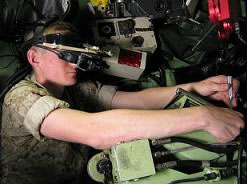Augmented Reality and Training
 |
| ARMAR guides military mechanic. |
Augmented reality can provide rich contextual learning for individuals learning a skill. Currently virtual reality and augmented reality applications are used for training in fields as diverse as trades, military and medicine.
The Military has long been a leader in the use of augmented reality especially in the area of training. Virtual displays layered over the field of vision of the user to enhance scenes using wearable head gear have become common. In 2009 Sarnoff Corporation demonstrated the first augmented reality training system for US Warfighters in what the military calls its Future Immersive Training Environment (FITE) Joint Capability Technology Demonstration (JCTD).The 36 Million dollar experiment allows soldiers to train at home to prepare for small, urban and borderless conflicts around the world. Sarnoff's head-mounted visualization training system combines real world views, computer generated images and avatars. Soldiers interact in a realistic training environment with their own weapon, while interacting with computer-generated avatars. The avatar responds realistically to the soldier’s actions by talking, avoiding contact or returning fire. The soldier is able to record and replay training sessions. [http://www.sarnoff.com/press-room/news/2009/11/30/FITE][http://io9.com/5144180/36-million-virtual-reality-game-to-train-us-soldiers]
The Military has also used AR to train users in maintenance and repair. See a video example [https://www.youtube.com/watch?v=mn-zvymlSvk Maintenance and Repair] According to Daniel Long of PC Lifestyle, the military are also, ''developing an Android phone app that overlays engines with schematics, potentially turning anybody into a mechanic.''[http://www.pcauthority.com.au/News/168086,20-hot-technologies
-to-watch-in-2010-augmented-reality.aspx]
In March 2010, the US Army put out a request for information on "Augmented Reality (AR) Systems Technology Roadmap Survey Dismounted Soldier Applications." Their objective is to explore, "methods of presenting 2D/3D virtual objects (representing various types of targets, fire and effects, friendly forces and opposition forces, civilians on the battlefield (COB), vehicles, etc.) to the dismounted soldier while operating both indoors and outdoors, on various types of live training environments. Additionally, the trainee would be capable of interacting with virtual targets, personnel, vehicles, etc. as though real. The objective is to create an interactive, multi-sensory, non-linear environment that provides the Warfighter with training that is unparalleled in flexibility and realism."[https://www.fbo.gov/index?s=opportunity&mode=form&tab
=core&id=2fd2cfe12f5d505472bcb31146ecf149]
Spencer Ackerman reports in Wired (July 6, 2012) that the Air Force is considering using smartphone apps for some of its training programs. Some proposed apps would teach Air Force Values, Fitness and Nutrition. Others would be games that help teach equipment components. They are looking for industry feedback on “industry technical capabilities, common industry standards, the latest technological advances, timelines for adaptation and/or integration, and any other common commercial terms and conditions related to mobile application.” (http://www.wired.com/dangerroom/2012/07/apps-air-force/ ) According to Ackerman the Air Education and Training Command also created an iphone/android app U.S. Air Force Airman Fundamentals, that with demos of required exercises and a personnel database for airmen to keep track of their families in a natural disaster.
For an excellent example of how augmented reality will be used by BMW for auto mechanics, click to see the movie on this website [http://www.bmw.com/com/en/owners/service/augmented_
reality_introduction_1.html BMW Augmented Reality:Introduction]
Fire Departments are using a mobile Augmented Reality Training Unit made by Resolve Fire & Hazard Response, Inc. to train participants to fight fires. Participants learn everything from the basics of fighting a small structure fire to how to handle a major HAZMAT incident. See a video here
[http://www.fdnntv.com/review.asp_Q_reviewID_E_6_A_title_E_Augmented_
Reality_Training_Unit FDNN TV Augmented Reality Training]
Medicine
In the field of medicine, augmented reality is being used to enhance visualization, plan operations and train medical staff in various procedures. In the past, surgeons constantly had to look away from an operating site to compare what they saw with static graphic scans. Augmented reality during an operation allows a surgeon to maintain a fixed view of a surgical site and have augmented graphic scans over their field of vision. In training situations, surgeons receive training on simulators that allow them to train and gain experience in a realistic AR operating room without risk to actual patients. AR allows learners to practice a process and get feedback during training.
Sanne Botden, a doctor and researcher from Eindhoven, Netherlands compared the performance of augmented reality and virtual reality surgical simulators to train doctors in laparoscopic surgery. She and her researchers made adjustments to their Augmented Reality simulator to provide on screen instructions and an opportunity to practice the process using real tissue, stitching material and instruments. The users were provided feedback on their skills. The virtual reality simulator did not mimic the surgery like the AR simulator and the instruments did not behave the same way as they would in real life. Using the AR simulator, participants learned the procedure in only eight sessions.
[http://www.news-medical.net/news/2009/03/31/47683.aspx]
Augmented Reality and Image Guided Robotic Surgery: Luc Soler, M.D.
An Augmented Reality Magic Mirror System for Anatomy Education
Next Up: Discovery-Based Learning and Augmented Reality
